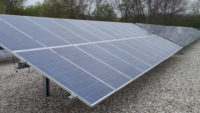
Mexico's national electricity agency recently commissioned construction of the $19.2-million, five megawatt Cerro Prieto photovoltaic plant in Baja California, to begin in early December. Located near Mexicali along the U.S.-Mexico border, the plant's four different solar technology lines are expected to help its owner, the Comisión Federal de Eletricidade, determine what type of utility-scale solar plants should follow in the region. CFE expressed interest in testing concentrated solar, crystalline silicon and amorphous silicon production technologies at Cerro Prieto.
The Baja location receives an estimated 6.4 kilowatt hours per square meter—favorable for solar insolation—and Mexico receives 5 kWh/sq m nationally, making it the country with the third-greatest solar potential globally. A study of the location isolation was included in a report commissioned from the U.S. Renewable Energy Laboratory in 1999 by CFE. The Cerro Prieto plant may also prove to be a source of exported energy to California through one of several cross-border electrical transmission lines.
The four types of PV technology being used in the plat are: a 1.5 MW PV plant with polycrystalline modules and a single-axis tracker system; a 1.5 MW PV plant with thin film modules and a single-axis tracker system; a 1.0 MW PV plant with polycrystalline modules and a double-axis tracker system; and a 1.0 MW PV plant with concentrated PV modules and a double-axis tracker system, says Juan José Iglesias Varela, project manager at Iberdrola Ingeniería y Construcción, Madrid.
Iberdrola, who won the bid for the Cerro Prieto plant, ordered 1.7 million polycrystalline solar modules from Siliken, Valencia, Spain. Siliken will begin operation of a solar module factory in Durango, Mexico.
"The Durango solar project will be ready to build in mid-summer 2012 and be constructed in stages of six months each, with about 40 MW of capacity added at each stage," says Manuel Vegara, the business development manager for Siliken LatAm, Mexico City. Siliken produces a wide range of solar equipment and has global distribution.
Iberdrola’s bid to build and operate the plant won out against 40 bidders. The company plans to hire a third of its work force locally, stimulating local Mexican economy. Mexico's secretariat of energy, SENER, calculates a two-year payback for the project.
Apart from the new solar installation, Iberdrola has made a $3 billion investment in Mexico's energy sector thus far, with some 5,000 MW of generation capacity, according to Eduardo Andrade, the corporate director in Mexico for Iberdrola, in Mexico City. As such, the company is the largest independent power producer in Mexico, and ranks second only to CFE in installed capacity.
Solar Joins Geothermal
The new solar facility will be constructed alongside the CFE's four geothermal plants, also near Mexicali. As a geothermal resource, Cerro Prieto is the largest in the country, with generating units ranging from 180 to 220 MW in capacity. Between 1977 and 1982, CFE worked closely with Lawrence Berkeley Laboratory to study the Cerro Prieto geothermal resource, under a bilateral agreement.
The Cerro Prieto geothermal plant produces 46 percent of the distributed electricity in Baja California, according to CFE. Under U.S.-Mexico protocol, electric power from Mexico can be transmitted to the United States with special U.S. presidential approval. The 2009 U.S.-Mexico Bilateral Framework on Clean Energy and Climate Change targets a strengthening of the cross-border electricity grid. The Cerro Prieto geothermal units sold electricity to the Los Angeles Department of Water & Power under a three-year power purchase agreement signed in 2009, and apparently renewed this year.
Mexico’s Focus on Renewables
Mexican President Felipe Calderón has made substantial effort to increase renewable energy sources during his tenure, and the national congress voted in April for a 35% renewable energy portfolio by 2024. The Cerro Prieto solar plant will help the government meet its increased generation goal within the current 2011-2025 energy plan, as well as its goal within the national strategy for climate change, which foresees 7,000 MW of new renewable energy in the country.
In December 2011, CFE also commissioned the 1-MW Santa Rosalía PV plant in Baja California Sur state, now being built by Mexico's Grupo Condumex, next to the Las Tres Vírgenes geothermal plant. Baja California Sur's Mulegé municipality indicated that the nearby project, which includes PV modules from Isofoton, would cost $6.1 million, according to a local report.
Similarly, the World Bank agreed in 2006 to finance $50 million toward the development of the 14 MW hybrid solar thermal power plant at Agua Prieta, in Sonora state. Bidding was delayed but now the parabolic collector technology will be supplied by Spain's Abengoa, under a concession issued earlier this year. The solar unity will be integrated with an existing gas generating unit in a hybrid solar/gas design, the country's first. Abengoa's Abener and Teyma construction subsidiaries will manage construction of the project.


Post a comment to this article
Report Abusive Comment